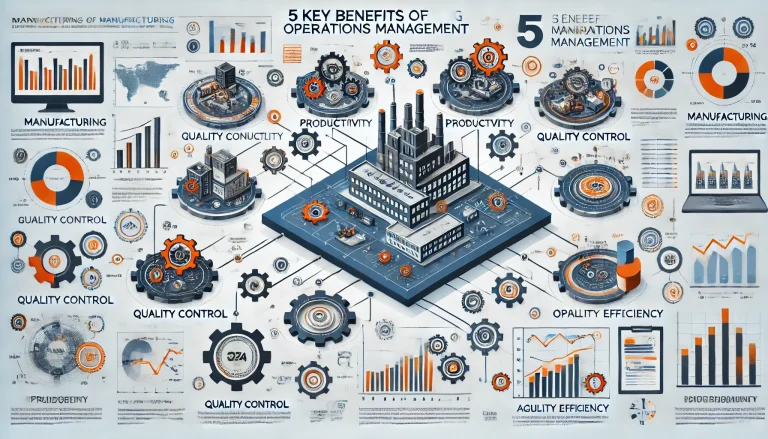Manufacturing Operations Management

Manufacturing Operations Management (MOM) stands at the forefront of modern industry, serving as the strategic backbone for optimizing production processes. In today’s rapidly evolving manufacturing landscape, MOM is more than just a framework—it’s a transformative approach that leverages cutting-edge technologies, data-driven insights, and streamlined workflows.
5 Key Benefits of Manufacturing Operations Management
In an increasingly competitive landscape, the efficiency and effectiveness of manufacturing processes can make or break a business. Manufacturing Operations Management (MOM) is more than just a buzzword; it’s a strategic approach that integrates people, processes, and technology to streamline production and enhance overall performance. By focusing on the intricacies of operations management, companies can unlock a multitude of advantages that not only boost productivity but also foster innovation and quality.
Whether you are a seasoned industrial leader or just stepping into the world of manufacturing, understanding the key benefits of MOM can help you optimize your operations, reduce costs, and ultimately drive success. In this blog post, we will explore five essential benefits of Manufacturing Operations Management that can transform your business and ensure you stay ahead in this dynamic sector.
Explore More Articles
1. Improved Efficiency and Productivity
One of the most significant benefits of manufacturing operations management is the substantial improvement in efficiency and productivity it brings to a production environment. By implementing streamlined processes and utilizing advanced technologies, organizations can optimize their workflows, reduce waste, and enhance overall output.
At the heart of improved efficiency is the ability to identify bottlenecks and inefficiencies within the production line. With a robust operations management system, manufacturers can track every aspect of their workflow in real time, allowing for swift adjustments and reallocations of resources as needed.
For instance, by analyzing production data, managers can pinpoint stages in the process that consistently lag behind and implement targeted interventions, such as reallocating labor or upgrading machinery, to rectify these issues.
Furthermore, effective operations management fosters a culture of continuous improvement. Employees are encouraged to participate in identifying areas for enhancement, which not only boosts morale but also leads to innovative solutions that can significantly elevate productivity levels. Regular training and skill development are integral to this process, ensuring that the workforce remains adept at using the latest technologies and methods, thus minimizing downtime and maximizing output.
Additionally, with better inventory management facilitated by operations management tools, manufacturers can reduce excess stock and avoid the costs associated with overproduction. This streamlined approach allows for a more agile response to market demands, ensuring that production levels align closely with customer needs while reducing lead times.
In summary, improved efficiency and productivity through MOM can lead to higher quality products, reduced operational costs, and ultimately, a stronger competitive edge in the marketplace. By focusing on these key areas, manufacturers can not only optimize their current operations but also set the foundation for sustainable growth and success in the future.
2. Enhanced Quality Control
Enhanced quality control is one of the most significant benefits of implementing effective manufacturing operations management (MOM) practices. In today’s competitive landscape, ensuring that products meet stringent quality standards is paramount for any manufacturing business. With a robust MOM system in place, companies can track and monitor quality metrics throughout the production process, identifying potential issues before they escalate into larger problems.
One way MOM enhances quality control is through the integration of real-time data analytics. By monitoring production lines continuously, manufacturers can detect variations in processes that may lead to defects. This proactive approach enables immediate corrective actions, reducing waste and minimizing the risk of faulty products reaching consumers. Additionally, the use of standardized operating procedures within MOM frameworks ensures that every employee follows best practices, resulting in consistent product quality.
Moreover, MOM facilitates better collaboration across departments, allowing for a seamless flow of information regarding quality standards and requirements. This interconnectedness fosters a culture of quality within the organization, empowering employees to take ownership of their roles in the production process. Regular training sessions and quality assurance audits become easier to implement, ensuring that team members are consistently updated on the latest quality control techniques.
Finally, enhanced quality control through MOM not only leads to improved products but also strengthens customer trust and satisfaction. When customers know they can rely on the quality of your products, they are more likely to become repeat buyers and advocates for your brand. In essence, a commitment to quality, supported by effective MOM practices, is a vital component of long-term success in the manufacturing industry.
3. Better Resource Management
Effective resource management is one of the most significant benefits of implementing manufacturing operations management (MOM) systems. With a structured approach to managing resources—whether they are human, machine, or material—manufacturers can optimize their operations to ensure that every component is utilized to its fullest potential.
First and foremost, with a robust MOM strategy, manufacturers can gain real-time visibility into their inventory levels, enabling them to track material usage and avoid shortages or overstock situations. This level of control minimizes waste and reduces carrying costs, allowing businesses to operate more efficiently. For instance, by analyzing consumption patterns and forecasting demand accurately, companies can adjust their purchasing strategies, ensuring that they have the right amount of materials on hand when needed.
Moreover, a well-implemented MOM system can enhance workforce management. By analyzing employee productivity and workload distribution, manufacturers can identify inefficiencies and ensure that labor resources are allocated effectively. This not only improves morale—by preventing employee burnout and ensuring fair workloads—but also maximizes productivity and output.
Additionally, machine management plays a crucial role in resource optimization. MOM systems can provide insights into equipment performance, maintenance schedules, and downtime analysis. By closely monitoring machine health and scheduling preventative maintenance, manufacturers can reduce unexpected breakdowns and extend the lifespan of their equipment. This proactive approach ultimately leads to increased uptime and production capacity, resulting in a more streamlined operation.
In summary, better resource management through manufacturing operations management leads to reduced costs, improved operational efficiency, and enhanced productivity. By optimizing inventory, workforce, and equipment usage, manufacturers can position themselves for long-term success and competitiveness in the market.
4. Increased Flexibility and Agility
In today’s fast-paced manufacturing environment, increased flexibility and agility have become critical components for success. Manufacturing Operations Management (MOM) empowers organizations to respond swiftly to market changes, customer demands, and production challenges. By leveraging advanced technologies, such as real-time data analytics and automation, companies can adjust their production schedules, resources, and workflows with remarkable ease.
For instance, when unexpected demand spikes or supply chain disruptions occur, manufacturers can quickly pivot their operations to prioritize high-demand products or reallocate resources to maintain efficiency. This adaptability not only helps in preventing costly downtime but also enhances the overall customer experience by ensuring timely delivery of products.
Moreover, a flexible manufacturing system allows for the integration of various production lines and processes, enabling companies to experiment with new products or variations without significant lead times. This capability fosters innovation and allows businesses to stay ahead of competitors. In short, MOM enhances a manufacturer’s ability to be agile and responsive, leading to improved operational efficiency and greater satisfaction for both employees and customers alike. By embracing increased flexibility, manufacturers position themselves to thrive amidst the ever-evolving landscape of the industry.
5. Data-Driven Decision Making
Data-driven decision-making has become a key component of efficient operations management in the fast-paced manufacturing environment of today. By harnessing the power of data, manufacturers can gain invaluable insights into their processes, leading to more informed choices that drive efficiency and productivity. The ability to collect, analyze, and interpret data from various stages of production allows managers to identify trends, uncover potential issues, and streamline workflows.
For instance, real-time data analytics tools, such as Siemens Opcenter, can reveal bottlenecks in the production line, enabling managers to allocate resources more effectively and minimize downtime. Moreover, predictive analytics can forecast future demand, helping manufacturers adjust their production schedules and inventory levels accordingly. This proactive approach not only enhances operational efficiency but also reduces waste and lowers costs.
Data-driven decision-making also promotes a continual improvement culture. By regularly reviewing performance metrics and key performance indicators (KPIs) within platforms like Siemens Opcenter, teams can identify areas for enhancement and implement strategies that lead to better outcomes. This cycle of evaluation and adjustment keeps organizations agile and responsive to changes in market conditions or consumer preferences.
Ultimately, leveraging data in manufacturing operations management empowers businesses to make strategic decisions that align with their goals, ensuring they remain competitive in an ever-evolving industry. The transition from intuition-based decisions to a data-driven approach not only enhances operational effectiveness but also cultivates a more transparent, accountable, and efficient manufacturing environment.
Siemens Opcenter is a well-known software suite for manufacturing operations management and is widely respected for its real-time analytics and decision-support capabilities. Let me know if you’d like to explore other software options!
Frequently Asked Questions
1. What is Manufacturing Operations Management (MOM)?
MOM is a strategic approach that integrates people, processes, and technology to optimize production workflows, enhance efficiency, improve quality, and reduce costs in manufacturing environments.
2. How does MOM improve efficiency and productivity?
MOM uses advanced technologies and real-time data analytics to streamline processes, reduce bottlenecks, and encourage continuous improvement. This results in better workflow optimization and higher overall output.
3. Can MOM help with quality control?
Yes, MOM systems enable real-time monitoring of production metrics, helping to detect potential defects early. This ensures that products consistently meet high-quality standards and enhances customer satisfaction.
4. How does MOM optimize resource management?
MOM provides visibility into inventory, workforce, and machinery performance. This allows manufacturers to allocate resources efficiently, minimize waste, and maximize productivity.
5. Is MOM beneficial for small and medium-sized manufacturers?
Absolutely. While traditionally used by large enterprises, modern MOM solutions are scalable and customizable, making them valuable for businesses of all sizes.
6. How does MOM support data-driven decision-making?
MOM collects and analyzes real-time data from various production stages, enabling manufacturers to identify trends, predict issues, and make informed decisions to enhance operations.
7. What role does MOM play in adapting to market changes?
MOM systems provide flexibility and agility, allowing manufacturers to adjust quickly to demand fluctuations, supply chain disruptions, or shifts in consumer preferences.
Conclusion
Manufacturing Operations Management is a game-changer for any organization looking to enhance performance and stay ahead in the competitive manufacturing sector. Its ability to drive efficiency, ensure quality, and enable agility sets it apart as a critical tool for success. By leveraging MOM, manufacturers can meet market demands, reduce costs, and exceed customer expectations—ultimately creating a foundation for sustainable success in the face of constant industry challenges.









